Bettas represent the most popular freshwater fish kept in home aquariums. With such alluring colors and elaborate tails, how could you resist them?
Whether you know them as bettas or “Siamese Fighting Fish,” you’ve probably glimpsed these iconic fish circling tiny bowls in a pet store.
The aggressive personalities of the males stand out every bit as much as their dramatic coloring.
They’re also relatively easy to maintain, appealing to aquarists at all stages in their career. However, such simplicity has prompted several misconceptions to arise.
If you aspire to add bettas to your aquarium, make sure you have all of the facts in hand. The last thing you want to do is harm your gorgeous new additions.
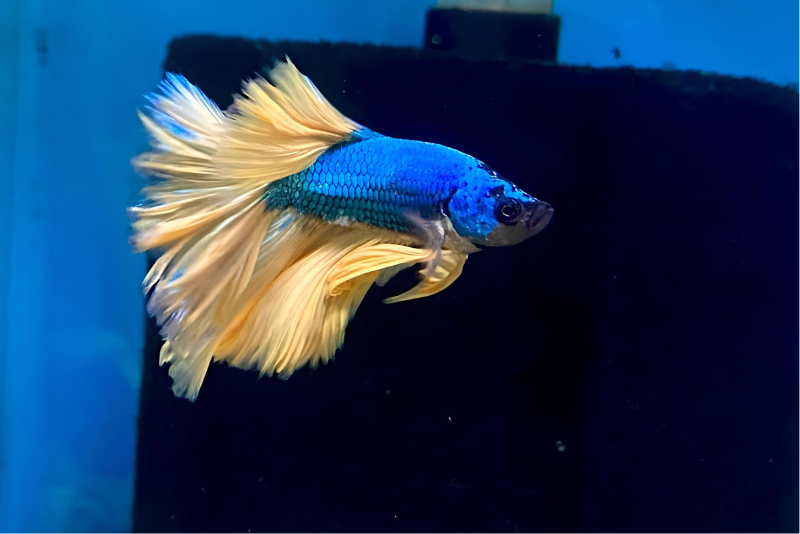
[toc]
Types of Bettas

If you’re new to the world of bettas, you may only consider that single species. Of course, you’ve seen myriad colors in the pet store, and maybe you noticed subtle differences here and there.
But did you realize each difference represented a specific type? Believe it or not, there are over SEVENTY types of bettas in the world!
Each species is classified based on their:
- Tail shape,
- Color,
- Pattern of their scales.
(Or all three – just to keep things interesting)
Bettas: Tail Types
That flowing tail is one of the most distinguishing characteristics of bettas. Wild bettas might have short tails, but selective breeding has created a variety of dramatic options.
Tail types are classified based on shape and size, and the name usually provides a clue.
1. Combtail Betta (Betta splendens var. Combtail)

Combtail bettas don’t have an unusual shape or size to their tails. You usually see a full, glorious tail in a typical round shape.
What sets this type of betta apart are the webbing and rays that extend through the tail fin itself.
The rays are quite prominent, with webs that extend at least two-thirds of the way between each ray.
It creates an effect similar to the coxcomb on a rooster’s head, which is where the name comes from. You’ll see a slightly spiked appearance as a result.
2. Crowntail Betta (Betta splendens var. Crowntail)

How to tell a crowntail from a combtail? It’s confusing because they’re very similar.
Both have the same rounded tails. You’ll also notice the same prominent rays and the webbing between the rays. It’s the length of that webbing that makes the difference.
The webbing on a crowntail is LESS than two-thirds of the length.
This enhances the spikey appearance, so your betta looks like it’s wearing an impressive crown across its back.
Some people think these types of bettas look insect-like due to those prominent rays.
3. Double Tail Betta (Betta splendens var. Double)

The gene for the double tail betta exists in every type of betta. What results is a betta with two distinct caudal fins.
It isn’t a simple split in the tail. There are two caudal peduncles for the tail to attach to, as well. The tails aren’t always identical in size, though (for show bettas), that’s the ideal.
While dramatic and beautiful, this type of betta comes at a price. For some reason, double tail bettas are more prone to swim bladder disorder.
4. Elephant Ear Betta (Betta splendens var. Elephant Ear)

Elephant ear bettas break the mold. They AREN’T named for their tails, colors, or patterns.
However, they usually fall into the tail category for simplicity’s sake. Instead of tail fin shape, they earn their name from the prominent pectoral fins on either side of their body.
Some people fondly refer to this type of betta as a Dumbo betta.
They resemble fanciful Flamenco dancers. Just take it easy on their water current as those fins make it difficult for them to swim correctly. They need a much gentler water flow than other types of bettas.
5. Halfmoon Betta (Betta splendens var. Halfmoon)

As you might expect, halfmoon bettas have tails in an elongated crescent of 180 degrees.
They also tend to have longer dorsal and anal fins than other types of bettas – a side effect of the selective breeding for their beautiful tails.
Halfmoons come with a few warnings. Those long, flowing fins are prone to tearing. This is known as “blowing a tail,” representing a site for infection to enter the body.
Also, for some reason, this type of betta is more aggressive than others.
6. Plakat Betta (Betta splendens var. Plakat)

If you’d like a more “traditional” type of betta, the plakat betta is the one for you.
These colorful fish most closely resemble the wild version. They have short, rounded tails, and some people mistake them for females.
Plakats have a faster swimming ability than other types of bettas. Unencumbered by those fancy fins, they can dart around the tank.
However, they also have a strong jumping ability, so keep a firm lid on the aquarium to prevent accidental escapes.
7. Rosetail Betta (Betta splendens var. Rosetail)

Rosetail bettas developed out of the halfmoon betta. The difference is extensive branching of the rays within the tail itself.
The branching creates a ruffled appearance similar to the folded petals of a rose – hence the name.
While stunning in appearance, rosetails require careful monitoring. This type of betta is prone to tail-biting behavior. They’ll attack and start chewing on their tails.
No one’s figured out the cause yet, but tail-biting DOES result in infection and possible loss of the tail.
8. Spade Tail Betta (Betta splendens var. Spade)

You’re familiar with a spade from a deck of cards, right? This is where this type of betta got its name.
The shape of their tail looks precisely like a spade turned on its side. The taper gives it just enough difference to distinguish it from a rounded tail.
Spades make an excellent compromise for aquarists that want a betta that’s unique but has some speed behind them.
The tail’s dramatic, but it doesn’t hinder their swimming ability as much as some of the more extreme tail designs out there.
9. Veiltail Betta (Betta splendens var. Veiltail)

The bettas you find in the pet store are almost always going to fall into the veiltail type. It’s the most dominant tail gene, and this type of betta breeds easier than any other.
While they can’t get considered “show bettas,” they rank at the top in popularity for aquariums.
Veiltails have long, droopy tails. The upper and lower segments of the tail aren’t symmetrical, assuming you get your veiltail to flare the tail in the first place.
That dragging weight makes these bettas slow swimmers. They’re NOT streamlined.
Bettas: Color Types
As crazy as it sounds, there are only three pigments that reside in the chromatophores (pigment cells) of bettas:
- Erythrin (red),
- Melanin (black),
- Xanthin (yellow).
The colors you see in individual types of bettas depend on the combination of the pigments and how deeply the chromatophores lie within the scale. (The deeper they are, the darker the pigment expresses itself)
In the wild, betta chromatophores change shape and size throughout their lives. This allows them to brighten their colors when they feel threatened or during the breeding season.-
Unhappily, domestic bettas don’t retain this ability (a result of selective breeding).
1. Blue Betta (Betta splendens var. Blue)
Blue bettas may not seem like they need a lot of description. Everyone knows the color blue, after all, right?
However, when you set out to add a blue betta to your collection, you have three different options to choose from.
The “blue wash” color is the easiest to track down. This is a standard blue color.

If you mix blue with tones of gray, it’s called a “steel-blue.”

And if you’re lucky enough to find a betta with bright, iridescent blue scales, it’s labeled a “royal blue betta”.
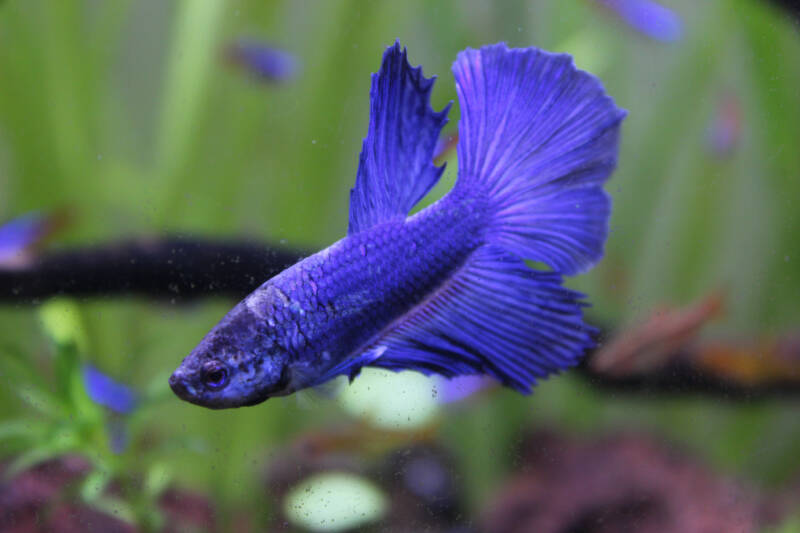
2. Red Betta (Betta splendens var. Red)

Just as the veiltail shows a dominant trait in all types of bettas, so does the red color. It’s the most prevalent of any color, which is why you often see it in pet stores.
Bettas of other color types may even have a “red wash” due to the prominence in their genetic code.

Solid-color red bettas look stunning in aquariums. The dazzling hue looks just as good as highlighted across the fins.

If your red bettas appear “washed out,” quickly check your water conditions. The fading red color’s an indication of poor health.
3. White Betta (Betta splendens var. White)

White bettas may seem plain and boring to some people.
With one of the more dramatic tail types, though, these bettas look majestic against a planted tank.
The stunning white color stands out against a mixture of colors in a community tank, too.
White bettas differ from the albino betta. Albinos are exceedingly rare, and they lack pigmentation, appearing dull rather than bright white.
Albino bettas are also notoriously unhealthy and prone to dying early. You’re better off with a white betta.
4. Yellow Betta (Betta splendens var. Yellow)

Due to the familiar presence of the yellow shade, yellow bettas may appear as “non-red” bettas. (Inventive, no?)
You’ll see a wide range in the yellow hue, from a soft butter up to vibrant sunshine.
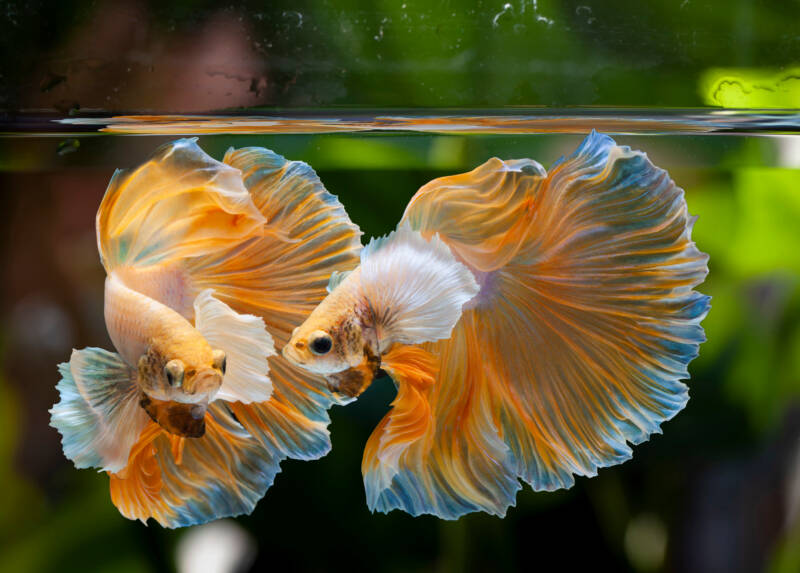
Included in the yellow type of betta is a version known as the pineapple betta.
These fish have the expected yellow color along with darker edges to their scales. This grants them the expected resemblance to the fruit, and it makes a more dramatic statement in your tank.
Bettas: Pattern Types
Iridocytes are cells that provide the metallic sheen to a fish’s scales. When combined with the pigments, bettas develop different patterns.
The expressions between the two create an entirely new grouping of bettas for you to choose from.
1. Cambodian Betta (Betta splendens var. Cambodian)

The Cambodian betta arose from careful selective breeding of light-colored bicolor bettas.
The body features a pale pink body branching out to bright red fins. Sometimes, the body is almost a flesh tone rather than pink.
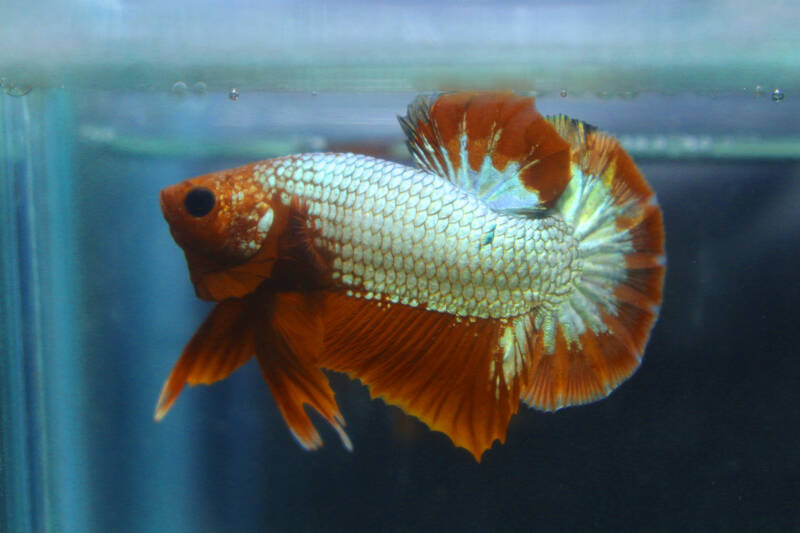
You may see other color variations than red in your Cambodian.It’s not that common, though. And the main body needs to retain that pale pink shade to officially hold the Cambodian name.
This type of betta is still relatively new, so they aren’t as easy to find.
2. Bicolor Betta (Betta splendens var. Bicolor)
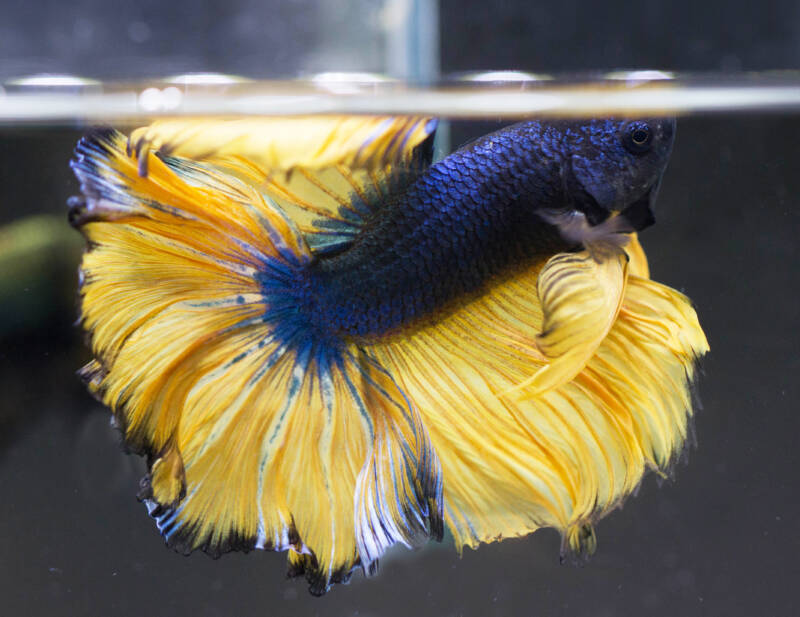
Bicolor bettas are common and easy to pick out. The fish sport one color on their bodies, with a second color on their fins.
Bicolors can only have TWO colors to qualify as this type of pattern. If they have more than two, they’re known as multicolored bettas.
There are light-colored bicolors, where the body is lighter in color than the fins.
Or you can find dark-colored bicolors, where the opposite is true: the body’s darker than the fins.
Contrasting colors are the preferred option (for show), but you can choose the colors you like.
3. Butterfly Betta (Betta splendens var. Butterfly)

As you might guess, butterfly bettas resemble the fluttering wings of a butterfly.
This type has a single color, typically, which gradually fades from the body to mid-way along the fins. The outside edge of the fin then remains white. You can see a second color on the outside of the fins in some butterflies.
Ideally, the split of the shade should be around half-way to meet show standards.
However, this is difficult to achieve, so as long as you get a beautiful change of color, you have a butterfly betta.
4. Dragon Scale Betta (Betta splendens var. Dragon)

Dragon scale bettas are one of the newest types of betta. As a result, you may need to find a specialized breeder to track one down.
The iridocytes play a big part in this type of betta, maximizing the scales’ metallic sheen. Dragon scales have rich colors with prominent iridescent scales.
The pattern along their sides resemble lizard scales. (Which is how they got their names).
The scales are larger than you see on most other types of bettas, making them stand out in a crowd.
Betta Myths
Bettas, regardless of type, hold a reputation as easy-to-manage colorful freshwater fish. They make stunning centerpiece additions to aquariums.
The simplicity surrounding their care has also prompted numerous assumptions to surface, leading to improper management.
Fish in a Bowl

Bettas share the same labyrinth organ as gouramis. This specialized structure, located above the gills, allows all labyrinth fish to “gulp air” at the surface to provide supplemental oxygen to their bodies.
It’s an evolutionary adaptation in response to their native environments. In the wild, bettas inhabit oxygen-poor waters. They favor ditches, rice paddies, and other shallow streams that may experience drought conditions.
The labyrinth organ allows them to continue to breathe even in the absence of quality oxygen.
Unfortunately, many people translate this to keeping bettas in tiny bowls or even flower vases.
Similar to goldfish, a small bowl is NEVER appropriate for fish! It allows the buildup of inappropriate waste products. Your betta will suffer and die.
The Lily Vase

Popular gifts include peace lilies containing a betta below the plant’s roots. Many believe the betta can thrive on the nutrients produced by the plant.
After all, bettas survive in rice paddies, right? The plant vases must work equally well.
Bettas are carnivores, not herbivores. The roots deny your betta the high levels of protein their diet demands! Also, the plant obscures their ability to reach the surface to breathe.
While such vases are beautiful, they’re NOT healthy systems for bettas!
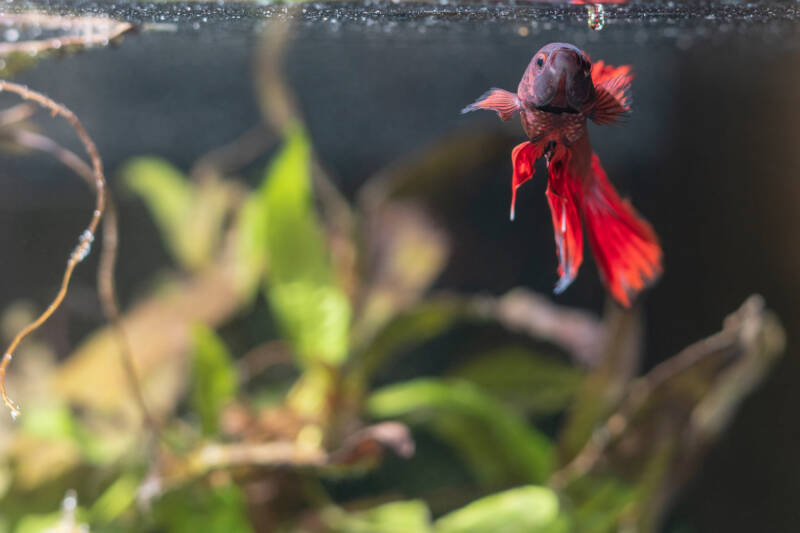
Betta Tank Setup
People deem every type of betta as easy to manage. However, many bettas pass away from poor tank choices and water quality.

If you want your bettas to remain healthy, take the time to do your homework and set up the best aquarium possible.
| Parameter | Range |
| Tank Size | 5-10 gallons (19-38 l) |
| Temperature | 76-84°F (24-29°C) |
| pH | 6.5-7.0 |
| Water Hardness | 5-35 dH |
| Nitrites | 0 ppm |
| Ammonia | 0 ppm |
| Nitrates | <20 ppm |
Bettas are tropical species, and they CANNOT survive in a tank without a heater.
Bowls or vases sitting out at room temperature fall several degrees BELOW the thermostat reading. A betta in cold water ends up with a suppressed immune system and quickly falls ill.
Make sure you get a filter for your tank, as well.

While it may sound like bettas are hardy – if they survive in ditches – a healthy tank is crucial for healthy fish. Wastes quickly build up when carnivores feed, and you don’t want your betta to develop an infection.
Tank Mates or Living solo

Most people are familiar with the pugnacious habits of male bettas.
The aggressive streak runs so strongly in some types of bettas, they’ll even attack their reflection. This prompts many people to believe bettas must stay alone.
Male bettas DON’T tolerate the presence of other males. That rings true. However, you CAN keep a single male with a group of females.
If you maintain an aquarium with heavy plantings, and you provide the right amount of space, a betta tank IS possible. Community tanks aren’t out of the question, either.

Depending on the type of betta you choose, they’re slow swimmers. Pairing them with one of the following groups is safe and makes for a colorful freshwater aquarium:
Ensure you avoid fish with a nipping habit, especially if you have types of bettas with luxurious fins. Like freshwater angelfish, they’ll end up prone to attack.
And skip guppies – bettas aren’t smart enough to figure out they’re not a betta!
Feeding Bettas

Bettas thriving in the wild vary their diet. They subsist on worms, mosquito larva, Daphnia, and smaller fish.
To keep your chosen type of betta looking their best, you want to recreate this menu as closely as possible. This isn’t as difficult as it seems. Freeze-dried foods retain all of their nutrients.
You can also rotate between live and frozen options. Popular items for bettas include:
- Bloodworms
- Brine shrimp
- Daphnia
Twice-daily feedings are PLENTY. You don’t want to overdo the amounts you offer, either.
Bettas are food-gorgers. They’ll eat until nothing remains in the tank. Not only does this slow down their ability to swim, but it can also kill them.
Bettas rely on their swim bladders to maintain their position in the tank. By inflating or deflating the swim bladder, they move up and down through the water column. Overeating increases their risk of swim bladder disorder.
Since you DON’T want a betta trapped on the bottom of the tank (or stuck at the top), monitor the amount you sprinkle.
The quantity they can finish in two minutes is more than enough. After all, that gruff attitude will ensure they get their share, even in a community tank.
History of the Betta

Bettas entered the domestic scene approximately 150 years ago.
Before becoming Thailand, the country was called Siam. Children noticed a particular fish in the rice paddies setting up individual territories.
When placed together, these fish would spar. (Hence the origin of the name “Siamese Fighting Fish)
Betting on the duels sprang up, catching the attention of the King. Recognizing a chance for profit, he set out to regulate the matches and placed a tax on betting.
Mythology led people to believe that bettas fought to the death. This wasn’t the case. Bettas are intelligent, and they only engaged in spars until one male is tired or elected to retreat.
People placed bets on the bravery of one fish or another, not the fish that was likely to survive.
Advancing to 1840, the King presented a specimen to Danish doctor Theodore Cantor. Dr. Cantor studied the fish, mistakenly classifying them as Macropodus pugnax.
It turned out there was already a fish by that name, though. (No one claimed doctors were brilliant)
Dr. Tate Regan later discovered the mistake. Seeing the stunning drama of the fish, he renamed them Betta splendens.
The name means “Beautiful warrior” – a name that suits these gorgeous freshwater fish much better.
The Modern Betta

Bettas migrated to the U.S. in 1910 with Frank Locke. Their name quickly ended up corrupted to “Beta” – as in the second letter of the Greek alphabet.
The correct pronunciation got lost. (Bettas were initially named “bet-tah” after the Asian Bettah warrior tribe)
Selective breeding grew in interest. Different colors, patterns, and tails came into favor. Aquarists combined hybrids with the original wild-type to create the fish you find today.
Few resemble the actual stock you find in ditches, slow-moving streams, or shallow pools.
Wild bettas lack the iconic dramatic fins. Instead, they have dull, grey-green scales and much shorter fins.

They’re native to the tropical waters of Cambodia, Laos, Thailand, and Vietnam. In Thailand, they’re called Plakat, or “biting fish.”
A Betta for Everyone
Bettas encompass an astounding array of colors and patterns.
If you’re interested in the results of decades of selective breeding, these freshwater fish make fantastic tank acquisitions.
Just skip that tiny bowl the pet store offers.
Do you share a passion for bettas? Which variety do you keep?
Let us know here!
